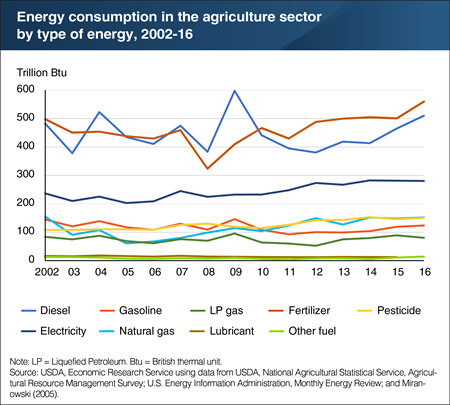In 2016, the agricultural sector consumed 1,872 trillion Btu of energy, accounting for about 1.9 percent of total U.S. primary energy consumption.
Farms consume energy in many forms, mainly diesel (44 percent of direct energy consumption), electricity (24 percent), natural gas (13 percent), gasoline (11 percent), and liquefied petroleum gas (7 percent).
Diesel and, to a lesser extent, gasoline are used to power farm machinery.
Electricity is used mainly for irrigation, cooling, and lighting.
Natural gas and LP gas are used in heating and grain drying. Large amounts of natural gas are required in the manufacturing of fertilizer and pesticide, so these amounts are categorized as indirect energy consumption on farms.
Overall, about three-fifths of energy in 2016 used in the agricultural sector was consumed directly on-farm, while two-fifths were consumed indirectly in the form of fertilizer and pesticides.
Recent increases in diesel and fertilizer consumption come in response to declining oil and natural gas prices.
From 2012 to 2015, agriculture became more energy intensive, as energy consumption grew over 10 percent compared with about 6 percent growth in agricultural output.
This chart updates data found in the ERS report, Trends in U.S. Agriculture’s Consumption and Production of Energy: Renewable Power, Shale Energy, and Cellulosic Biomass, released August 2016.
 |
|---|
Source: USDA news release



Leave A Comment